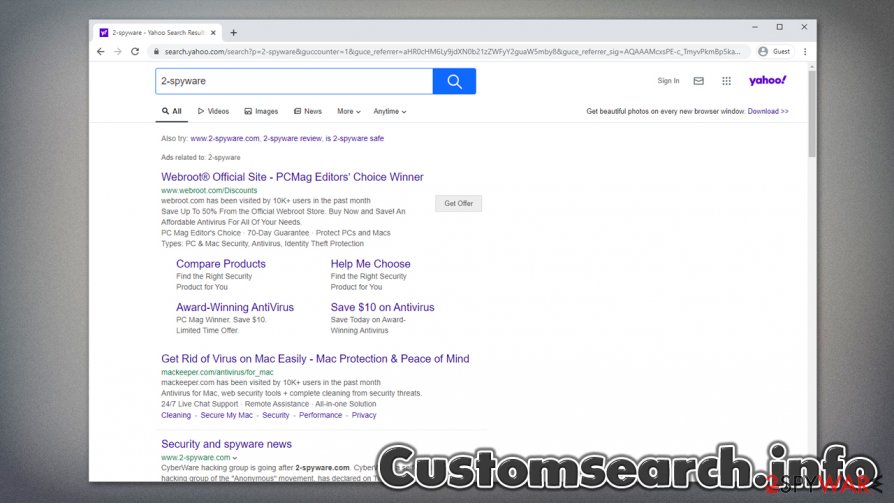Customsearch.info (Easy Removal Guide) - Free Instructions
Customsearch.info Removal Guide
What is Customsearch.info?
Customsearch.info – a custom search engine with browser-hijacking features

Customsearch.info is an address that users might see on their Google Chrome, Mozilla Firefox, Safari, or another web browser unexpectedly. This is because a Custom Search extension was installed on the browser without asking for permission – potentially unwanted programs are usually spread in deceptive manner, including software bundle packages or misleading advertisements/fake updates.
Once installed, the app will change the settings of the web browser by setting hxxps://customsearch.info as a homepage and new tab address, and apply a customized search engine. Thus, users who have their browsers hijacked are forced to browse the web via an alternative search provider – Customsearch.info redirects all searches to Yahoo. However, unlike genuine Yahoo results, the hijacker will insert multiple sponsored links (marked as “Ads”) at the top for users to click and earn revenue for the developers.
| Name | Customsearch.info |
| Type | Browser hijacker, potentially unwanted program |
| Related | Custom Search browser extension |
| Distribution | In most cases, users install the PUP unintentionally when downloading other software from the internet (software bundling), although sometimes they might be tricked by an attractive ad or deceptive prompt |
| Risks | Installation of other potentially unwanted programs or malware, personal information disclosure to unknown parties, monetary losses |
| Elimination | You can uninstall potentially unwanted applications by following our manual guide below or by scanning the device with powerful anti-malware software |
| Optional steps | If you are unable to eliminate some of the extensions, you can reset the relevant browsers, as explained below. If you found more unwanted apps or malware on your computer, user FortectIntego repair tool to fix performance issues that they might have caused |
While browser hijackers such as Customsearch.info are not considered a major security threat, it is important to note that they have plenty to hide. Custom Search toolbar is just another app that was duplicated from Nebula Search, Blast Search, Storm Search, Mazy Search, and many others. In other words, the developer keeps distributing the same app under different names – one of many suspicious (but typical) behaviors.
However, there are many more deceptive features of Customsearch.info browser hijacker, which include:
- Changing users' search provider and homepage without permission;
- Preventing users from searching the web via the preferred engine;
- Inserting sponsored links and ads into the top of the search results;
- Tracking and anonymous, as well as personal, information;
- Being difficult to eliminate due to various persistence techniques.
Information gathering practices are not uncommon, although absolutely unnecessary when it comes to browser hijackers or other PUPs. Keep in mind that your data is valuable, and it can be sold for profits. In the meantime, you might be targeted by various ad campaigns, and they might be extremely persistent and annoying.
Some people might even refer to the hijacker as the Customsearch.info virus, as it can appear unexpectedly. While not technically correct, this term can be understandable, considering that users find their web browser settings completely changed: a new search engine applied, and searches being redirected to Yahoo.
Software bundling or deceptive advertisements are one of the most common methods that browser hijackers are distributed – these techniques typically result in unintentional installation. Without a doubt, you should not tolerate such deceptive behavior and remove Customsearch.info from your browser.

However, Customsearch.info removal might sometimes be much more complicated than you would expect from a regular browser extension. First of all, the homepage, new tab, and search engine changes might not be directly linked to the Custom Search extension but rather a program installed on the device.
In such a case, instead of performing regular Customsearch.info uninstall by right-clicking on the extension, you will have to look for suspicious programs installed on your machine – we explain how below.
Additionally, the PUP might set the “Managed by your organization” function on your browser – it is a new trick used by browser hijacker developers in order to prevent users from removing unwanted extensions. If that occurs, experts[1] highly recommend you scan the device with anti-malware, reset web browsers, and use system repair tools such as FortectIntego for best results.
Learn to install applications correctly
While potentially unwanted applications can be installed deliberately without knowing about their features, most installations occur behind users' backs. One of the main culprits for such occurrence is software bundling – a technique that is used by most freeware[2] distributors and developers. It allows the pay-per-install[3] monetization principle (which is not always used for dubious purposes, by the way) to be practiced, so third-parties are extremely interested in users installing additional apps. Unfortunately, they are often going out of their ways in order to achieve the desired effect and do not adequately show the optional components within the installer.
Therefore, you should always pay close attention to your downloads – here are a few tips that might help you:
- If possible, avoid third-party sites and download apps from the official sources only;
- Do not get tricked by fake “Download” buttons (this is especially prevalent on torrent and other insecure sites);
- Once the installation wizard shows up, do not click “Next” until you are done with the process;
- If prompted, always pick Advanced/Custom instead of Recommended/Quick settings to stay in control of the installation process;
- Read through the instructions carefully and remove ticks from checkboxes, decline all the offers and read the fine print text;
- Install powerful anti-malware software capable of detecting PUPs.

Customsearch.info removal instructions
As mentioned above, Customsearch.info removal should not cause major difficulties to most. However, if the app was installed through an insecure source (such as software crack), it could have set the “Managed by your organization” status, which would prevent users from modifying their browser settings. In such a case, you should remove Customsearch.info by resetting your web browser – check the instructions below.
If the hijack was caused by an installed program, you should follow the guide below to eliminate it manually. Alternatively, you could simply scan your computer with powerful anti-malware software – it will find all the unwanted entries within various folders of your system and uninstall the Customsearch.info virus automatically.
You may remove virus damage with a help of FortectIntego. SpyHunter 5Combo Cleaner and Malwarebytes are recommended to detect potentially unwanted programs and viruses with all their files and registry entries that are related to them.
Getting rid of Customsearch.info. Follow these steps
Uninstall from Windows
To remove unwanted applications from Windows, access the Control Panel > Programs & Features section:
Instructions for Windows 10/8 machines:
- Enter Control Panel into Windows search box and hit Enter or click on the search result.
- Under Programs, select Uninstall a program.

- From the list, find the entry of the suspicious program.
- Right-click on the application and select Uninstall.
- If User Account Control shows up, click Yes.
- Wait till uninstallation process is complete and click OK.

If you are Windows 7/XP user, proceed with the following instructions:
- Click on Windows Start > Control Panel located on the right pane (if you are Windows XP user, click on Add/Remove Programs).
- In Control Panel, select Programs > Uninstall a program.

- Pick the unwanted application by clicking on it once.
- At the top, click Uninstall/Change.
- In the confirmation prompt, pick Yes.
- Click OK once the removal process is finished.
Delete from macOS
If you are using a Mac, follow this guide:
Remove items from Applications folder:
- From the menu bar, select Go > Applications.
- In the Applications folder, look for all related entries.
- Click on the app and drag it to Trash (or right-click and pick Move to Trash)

To fully remove an unwanted app, you need to access Application Support, LaunchAgents, and LaunchDaemons folders and delete relevant files:
- Select Go > Go to Folder.
- Enter /Library/Application Support and click Go or press Enter.
- In the Application Support folder, look for any dubious entries and then delete them.
- Now enter /Library/LaunchAgents and /Library/LaunchDaemons folders the same way and terminate all the related .plist files.

Remove from Microsoft Edge
Delete unwanted extensions from MS Edge:
- Select Menu (three horizontal dots at the top-right of the browser window) and pick Extensions.
- From the list, pick the extension and click on the Gear icon.
- Click on Uninstall at the bottom.

Clear cookies and other browser data:
- Click on the Menu (three horizontal dots at the top-right of the browser window) and select Privacy & security.
- Under Clear browsing data, pick Choose what to clear.
- Select everything (apart from passwords, although you might want to include Media licenses as well, if applicable) and click on Clear.

Restore new tab and homepage settings:
- Click the menu icon and choose Settings.
- Then find On startup section.
- Click Disable if you found any suspicious domain.
Reset MS Edge if the above steps did not work:
- Press on Ctrl + Shift + Esc to open Task Manager.
- Click on More details arrow at the bottom of the window.
- Select Details tab.
- Now scroll down and locate every entry with Microsoft Edge name in it. Right-click on each of them and select End Task to stop MS Edge from running.

If this solution failed to help you, you need to use an advanced Edge reset method. Note that you need to backup your data before proceeding.
- Find the following folder on your computer: C:\\Users\\%username%\\AppData\\Local\\Packages\\Microsoft.MicrosoftEdge_8wekyb3d8bbwe.
- Press Ctrl + A on your keyboard to select all folders.
- Right-click on them and pick Delete

- Now right-click on the Start button and pick Windows PowerShell (Admin).
- When the new window opens, copy and paste the following command, and then press Enter:
Get-AppXPackage -AllUsers -Name Microsoft.MicrosoftEdge | Foreach {Add-AppxPackage -DisableDevelopmentMode -Register “$($_.InstallLocation)\\AppXManifest.xml” -Verbose

Instructions for Chromium-based Edge
Delete extensions from MS Edge (Chromium):
- Open Edge and click select Settings > Extensions.
- Delete unwanted extensions by clicking Remove.

Clear cache and site data:
- Click on Menu and go to Settings.
- Select Privacy, search and services.
- Under Clear browsing data, pick Choose what to clear.
- Under Time range, pick All time.
- Select Clear now.

Reset Chromium-based MS Edge:
- Click on Menu and select Settings.
- On the left side, pick Reset settings.
- Select Restore settings to their default values.
- Confirm with Reset.

Remove from Mozilla Firefox (FF)
Remove dangerous extensions:
- Open Mozilla Firefox browser and click on the Menu (three horizontal lines at the top-right of the window).
- Select Add-ons.
- In here, select unwanted plugin and click Remove.

Reset the homepage:
- Click three horizontal lines at the top right corner to open the menu.
- Choose Options.
- Under Home options, enter your preferred site that will open every time you newly open the Mozilla Firefox.
Clear cookies and site data:
- Click Menu and pick Settings.
- Go to Privacy & Security section.
- Scroll down to locate Cookies and Site Data.
- Click on Clear Data…
- Select Cookies and Site Data, as well as Cached Web Content and press Clear.

Reset Mozilla Firefox
If clearing the browser as explained above did not help, reset Mozilla Firefox:
- Open Mozilla Firefox browser and click the Menu.
- Go to Help and then choose Troubleshooting Information.

- Under Give Firefox a tune up section, click on Refresh Firefox…
- Once the pop-up shows up, confirm the action by pressing on Refresh Firefox.

Remove from Google Chrome
Reset Google Chrome if you are unable to uninstall Custom Search extension manually:
Delete malicious extensions from Google Chrome:
- Open Google Chrome, click on the Menu (three vertical dots at the top-right corner) and select More tools > Extensions.
- In the newly opened window, you will see all the installed extensions. Uninstall all the suspicious plugins that might be related to the unwanted program by clicking Remove.

Clear cache and web data from Chrome:
- Click on Menu and pick Settings.
- Under Privacy and security, select Clear browsing data.
- Select Browsing history, Cookies and other site data, as well as Cached images and files.
- Click Clear data.

Change your homepage:
- Click menu and choose Settings.
- Look for a suspicious site in the On startup section.
- Click on Open a specific or set of pages and click on three dots to find the Remove option.
Reset Google Chrome:
If the previous methods did not help you, reset Google Chrome to eliminate all the unwanted components:
- Click on Menu and select Settings.
- In the Settings, scroll down and click Advanced.
- Scroll down and locate Reset and clean up section.
- Now click Restore settings to their original defaults.
- Confirm with Reset settings.

Delete from Safari
Remove unwanted extensions from Safari:
- Click Safari > Preferences…
- In the new window, pick Extensions.
- Select the unwanted extension and select Uninstall.

Clear cookies and other website data from Safari:
- Click Safari > Clear History…
- From the drop-down menu under Clear, pick all history.
- Confirm with Clear History.

Reset Safari if the above-mentioned steps did not help you:
- Click Safari > Preferences…
- Go to Advanced tab.
- Tick the Show Develop menu in menu bar.
- From the menu bar, click Develop, and then select Empty Caches.

After uninstalling this potentially unwanted program (PUP) and fixing each of your web browsers, we recommend you to scan your PC system with a reputable anti-spyware. This will help you to get rid of Customsearch.info registry traces and will also identify related parasites or possible malware infections on your computer. For that you can use our top-rated malware remover: FortectIntego, SpyHunter 5Combo Cleaner or Malwarebytes.
How to prevent from getting browser hijacker
Do not let government spy on you
The government has many issues in regards to tracking users' data and spying on citizens, so you should take this into consideration and learn more about shady information gathering practices. Avoid any unwanted government tracking or spying by going totally anonymous on the internet.
You can choose a different location when you go online and access any material you want without particular content restrictions. You can easily enjoy internet connection without any risks of being hacked by using Private Internet Access VPN.
Control the information that can be accessed by government any other unwanted party and surf online without being spied on. Even if you are not involved in illegal activities or trust your selection of services, platforms, be suspicious for your own security and take precautionary measures by using the VPN service.
Backup files for the later use, in case of the malware attack
Computer users can suffer from data losses due to cyber infections or their own faulty doings. Ransomware can encrypt and hold files hostage, while unforeseen power cuts might cause a loss of important documents. If you have proper up-to-date backups, you can easily recover after such an incident and get back to work. It is also equally important to update backups on a regular basis so that the newest information remains intact – you can set this process to be performed automatically.
When you have the previous version of every important document or project you can avoid frustration and breakdowns. It comes in handy when malware strikes out of nowhere. Use Data Recovery Pro for the data restoration process.
- ^ Losvirus. Losvirus. Cybersecurity news and malware insights.
- ^ Tim Fisher. What Is Freeware?. Lifewire. Tech News, Reviews, Help & How-Tos.
- ^ What is Pay-Per-Install?. CodeFuel. Monetization solutions for websites, extensions, apps, and search engines.
